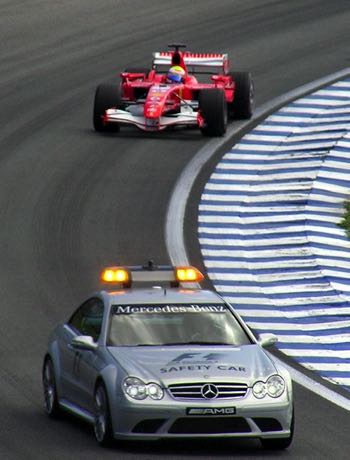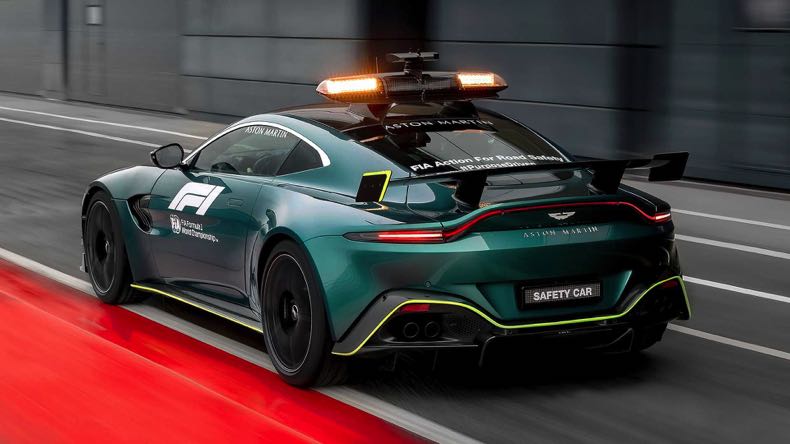
In various forms of motorsport, a pace car or safety car is a separate vehicle to those competing, the job of which is to limit the speed of the cars in the race which all stack up behind in times of danger. This happens when there has been an accident on the track, or when bad weather means conditions are seen as being dangerous.
During a safety car or ‘caution’ period, a high-performance car (though slower than competing cars), will enter the track from the pit lane ahead of the leading car. During this time, competitors are not usually allowed to pass other cars and change the order of the race as it was when the safety car entered. They may also not pass the safety car itself.
The car then leads the field of competitors at a pre-determined pace, deemed safe for the conditions, which may vary depending on the circumstances. When the safety car period ends, the car will leave the track and normal racing can resume. While safety cars entered Formula 1 in 1973 at the Canadian Grand Prix, they were first used as far back as 1911 during the very first Indianapolis 500.
Safety Car Procedure in F1

In Formula 1, should particularly bad weather including heavy rain or an accident occur, this may prevent normal racing from taking place safely. If that happens, the Race Director can then call on a ‘safety car period’. The safety car period starts by marshals waving yellow flags and ‘SC’ boards are also shown. In modern times, F1 cars have LED light displays in the cockpit or on the steering wheel which inform the driver which flags are being shown next to the track. The yellow LED means the safety car has been deployed.
Safety cars in Formula 1 have green and orange lights mounted on the roof. Green lights are displayed when it is safe and permitted to pass the safety car. As of 2015, the safety car no longer has to wait until all stragglers have caught up to the main field. As soon as the car is ready to leave the track, the orange light is switched off which indicates that it will head into the pits at the end of the current lap. Safety car laps still count in the race.
The leading car will be close behind the safety car at this point. Drivers continue in formation until they cross the initial safety car line, where green lights then indicate that racing is back on once more. Only professional drivers are used to pilot safety cards. While the basic idea of a safety car is to slow the field down, the high-performance vehicles used must be driven at a speed fast enough to ensure that the F1 cars’ tyres are kept up to their proper operating temperature. Co-drivers are used for communication.
Safety Car Stats in F1

As of the end of the 2021 season, the following stats can be attributed to safety car use in Formula 1 since it was introduced in 1973.
- 13 Grands Prix have had to start behind a safety car.
- 8 Grands Prix have finished behind a safety car.
- The longest safety car period of all time was 19 laps. This happened at the 2007 Japanese Grand Prix. The race begun behind the safety car due to inclement weather.
- Safety cars have been deployed no less than 287 times in Formula 1 across 199 individual races.
- The safety car has led F1 cars for more than 1000 laps to date.
- The most safety car introductions in a season is 21. This happened in 2019. 20 more were needed in 2020.
- The most safety car deployments in a single Grand Prix is 6. This happened during the 2011 Canadian Grand Prix.
Safety Car Models

The primary function of a safety car is self-explanatory. The make and model of the safety car in a given season can change depending on needs and of course, depending on money and sponsorship deals.
The type of car used then is of no consequence to most of us. But for petrolheads and F1 history freaks, these are the car types that have been used since the safety car was introduced in 1973, right up to the Abu Dhabi Grand Prix in 2021, along with their enigmatic drivers. While not as rapid as any Formula 1 car, the below list is made up of any amount of cars the vast majority of us would love to have in the garage!
| Years in Use | Car | Driver |
|---|---|---|
| 1973 | Porsche 914 | Eppie Wietzes |
| 1976 | Porsche 911 Turbo | Eppie Wietzes |
| 1981-1983 | Lamborghini Countach | Eppie Wietzes |
| 1992-1994 | Ford Escort RS Cosworth | Mark Goddard |
| 1993 | Fiat Tempra 16V | Mark Goddard |
| 1993-1994 | Opel Vectra | Mark Goddard/Max Angelelli |
| 1994 | Porsche 911 | Max Angelelli |
| 1994 | Honda Prelude | Max Angelelli |
| 1995-1996 | Renault Clio Williams | Jean Ragnotti |
| 1995 | Lamborghini Diablo | Jean Ragnotti |
| 1995 | Porsche 993 GT2 (911 GT) | Jean Ragnotti |
| 1996-1997 | Mercedes C36 AMG | Jean Ragnotti/Oliver Gavin |
| 1997-1998 | Mercedes CLK55 AMG | Oliver Gavin |
| 1999-2000 | Mercedes CL55 AMG | Oliver Gavin/Bernd Mayländer |
| 2001-2002 | Mercedes SL 55 AMG | Bernd Mayländer/Marcel Fassler |
| 2003 | Mercedes CLK 55 AMG | Bernd Mayländer |
| 2004-2005 | Mercedes SLK 55 AMG | Bernd Mayländer |
| 2006-2007 | Mercedes CLK 63 AMG | Bernd Mayländer |
| 2008-2009 | Mercedes SL 63 AMG | Bernd Mayländer |
| 2010-2014 | Mercedes SLS AMG | Bernd Mayländer |
| 2015-2017 | Mercedes AMG GT S | Bernd Mayländer |
| 2018-2021 | Mercedes AMG GT R | Bernd Mayländer |
| 2021 | Aston Martin Vantage | Bernd Mayländer |
